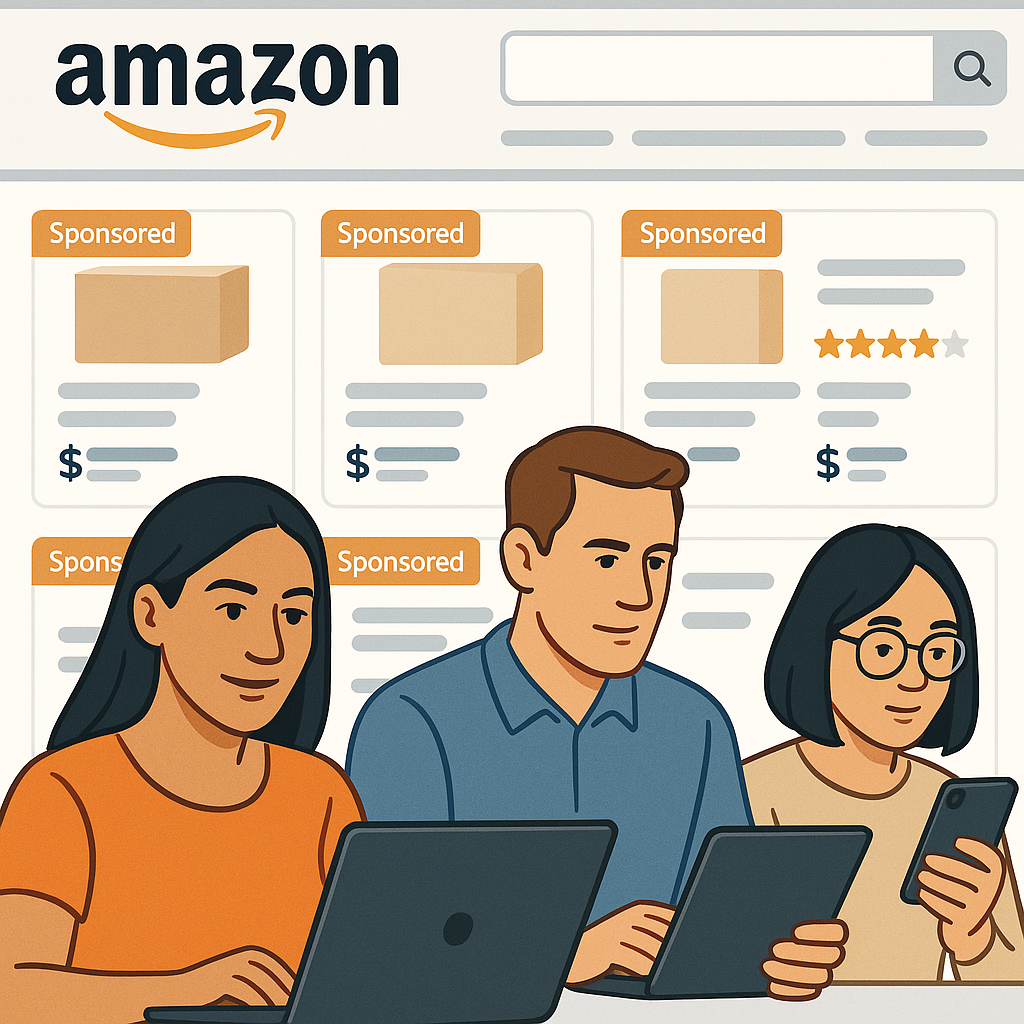Amazon Sponsored Products: The Complete Seller’s Guide
Amazon Sponsored Products is a powerful pay-per-click advertising solution that enables sellers to promote individual products directly within Amazon’s marketplace. For both emerging brands and established sellers, these ads represent a critical pathway to visibility in an increasingly competitive marketplace. With millions of products vying for shopper attention, Sponsored Products provide a strategic advantage by placing your offerings exactly where customers are actively searching and buying.
This comprehensive guide will walk you through everything from basic setup to advanced optimization techniques, including automation strategies, proven best practices, and expert-level tips to maximize your cost-per-click advertising on Amazon.
What are Amazon Sponsored Products & why do they matter?
Amazon Sponsored Products are pay-per-click advertisements that appear in high-visibility positions across the marketplace—primarily in search results and on product detail pages. These ads operate through an auction-based system where sellers bid on specific keywords or products relevant to their offerings. When a shopper clicks on your sponsored listing, they’re directed to your product detail page, and you’re charged for that click regardless of whether a purchase occurs.
For sellers, these advertisements deliver several compelling advantages:
- Enhanced visibility that places products directly in shoppers’ paths when they’re actively searching
- Increased conversion potential by targeting users with high purchase intent
- Flexible budget management with no minimum spend requirements
- Comprehensive analytics to track performance and refine strategies
- Potential boost to organic ranking as successful ads generate sales signals
The impact of these promotional tools cannot be overstated. Many sellers report significant improvements in product discovery, particularly for new listings that haven’t yet established organic ranking. A furniture brand that recently launched on the platform saw a 267% increase in visibility during their first month after implementing Sponsored Product Ads, transforming their launch trajectory from slow growth to immediate market presence.
The competitive landscape of Amazon’s marketplace makes advertising not just beneficial but increasingly necessary. With over 9.7 million sellers worldwide competing for customer attention, Sponsored Products provide a strategic method to rise above the noise and connect directly with your target audience at the moment they’re ready to purchase.
How Amazon Sponsored Products work: the fundamentals
Understanding the mechanics behind Amazon’s advertising platform is essential before launching your campaigns. At its core, the system operates through two primary targeting approaches: automatic and manual.
With automatic targeting, Amazon’s algorithms determine when to show your advertisements based on your product information. The system analyzes your listing details—including title, bullet points, description, and backend keywords—to match your items with relevant customer searches. This approach requires minimal setup but offers less control over which terms trigger your ads.
Manual targeting puts you in the driver’s seat, allowing specific selection of keywords or products that will activate your advertisements. This method demands more initial investment of time but enables precise targeting of high-value search terms and strategic competitor products.
Regardless of targeting method, all campaigns operate within Amazon’s auction system. When a customer performs a search, an instantaneous auction occurs among advertisers bidding on related terms. Winners earn placement based on a combination of factors:
- Bid amount (what you’re willing to pay per click)
- Relevance (how well your product matches the search)
- Historical performance (click-through and conversion rates)
Sponsored listings can appear in multiple positions: at the top of search results, throughout the search pages, on product detail pages, and even on competitors’ listings. This visibility network ensures your products remain prominent throughout the customer journey.
To participate, sellers must meet specific eligibility requirements, including an active professional seller account in good standing, products in eligible categories, and listings that comply with Amazon’s policies regarding image quality, detail completeness, and prohibited content.
Placement and auction system deep dive
The Amazon PPC auction model uses a second-price mechanism—you pay one cent more than the next highest bidder rather than your full bid amount. This system rewards efficient bidding strategy over merely outspending competitors.
Advertisement placement quality depends heavily on Amazon’s assessment of ad relevance. This evaluation considers your product’s title, description, specifications, reviews, historical performance data, and how well these elements align with customer search behavior. Highly relevant listings with strong performance metrics can win placements even with lower bids than competitors, making optimization an ongoing process rather than simply a bidding war.
Step-by-step: setting up your first Amazon Sponsored Products campaign
Creating your initial campaign requires methodical preparation and execution.
Follow these steps to establish a solid foundation for your advertising efforts.
- Navigate to Campaign Manager – Log into Seller Central and locate the “Advertising” tab in the main menu. Select “Campaign Manager” to access the advertising platform.
- Establish clear naming conventions – Develop a consistent naming structure that identifies product lines, targeting types, and campaign purposes. For example: “BrandX-KitchenTools-Manual-Competitors” clearly indicates what you’re advertising and how.
- Select products strategically – Choose items with:
- Sufficient inventory to support increased demand
- Competitive pricing relative to similar offerings
- Strong review ratings (ideally 3.5 stars or higher)
- Optimized detail pages with high-quality images and compelling copy
- Choose your targeting approach – For new sellers, begin with automatic targeting to gather data on which search terms convert. Experienced marketers may start with manual campaigns targeting researched keywords.
- Conduct keyword research – Identify relevant search terms through:
- Amazon’s “Search Terms Report” from existing campaigns
- The search suggestion bar on Amazon’s site
- Third-party research tools specifically designed for marketplace optimization
- Set appropriate budgets and bids – New sellers should start conservatively, with daily budgets of $10-25 per campaign and default bids between $0.50-1.00. Experienced sellers may allocate higher amounts based on previous performance data.
- Configure campaign settings – Determine campaign duration (continuous or fixed dates) and select your bidding model:
- Fixed bids (you set specific amounts)
- Dynamic bids – down only (Amazon lowers bids when conversion appears less likely)
- Dynamic bids – up and down (Amazon adjusts bids in both directions based on conversion probability)
- Launch and monitor – Activate your campaign and establish a regular schedule for reviewing performance metrics, particularly focusing on impressions, clicks, and conversion rates during the initial days.
Remember that your first campaigns serve dual purposes: generating sales and collecting valuable data that will inform your optimization strategy. Allow new campaigns at least 7-10 days of runtime before making significant adjustments to gather sufficient performance data.
For sellers managing multiple products, consider launching a mix of automatic and manual campaigns simultaneously. This approach provides immediate visibility while building the data foundation needed for refined targeting. Amazon ads campaign management solutions can help streamline this process as your advertising portfolio grows.
Advanced optimization strategies for Sponsored Products success
Moving beyond basic campaign setup, sophisticated optimization techniques separate profitable advertising from wasteful spending. Implement these data-driven strategies to maximize return on investment.
Keyword refinement
Successful campaigns require continuous keyword evolution based on performance data:
- Harvest converting search terms – Regularly review automatic campaign reports to identify unexpected search terms driving sales. Transfer these winners to manual campaigns where you can control bidding more precisely.
- Implement negative keywords – Exclude irrelevant search terms that generate clicks without conversions. This prevents wasted spend and improves campaign efficiency.
- Expand with long-tail variations – Add specific, multi-word phrases that typically have lower competition but higher conversion intent. For example, rather than just bidding on “yoga mat,” include “non-slip yoga mat for hot yoga.”
Bid optimization
Strategic bid management directly impacts profitability:
- Adjust based on ACoS – Increase bids on keywords with Advertising Cost of Sale below your target threshold. Scale back on terms exceeding your profitability limits.
- Placement bid adjustments – Analyze the placement report to determine where conversions occur. Consider increasing bid modifiers for top-of-search placements if they demonstrate higher conversion rates.
- Dayparting strategies – Identify high-performance time periods and increase bids during peak conversion hours while reducing exposure during underperforming times.
Product detail page optimization
Remember that advertising effectiveness ultimately depends on conversion after the click:
- Align ad keywords with page content – Ensure search terms bringing visitors to your listing actually appear in your title, bullets, or description.
- Enhance visual appeal – Upgrade product photography, add lifestyle images, and implement video when possible to increase conversion rates.
- Address common objections – Review customer questions and competitor reviews to identify hesitation points, then proactively address these concerns in your listing copy.
Campaign structure refinement
Organizational improvements facilitate more precise optimization:
- Single-product ad groups – Separate high-priority products into individual ad groups for more granular performance tracking and optimization.
- Search term isolation – Create dedicated campaigns for top-performing keywords using exact match to maximize control over high-value terms.
- Category segmentation – Organize campaigns by product categories to align budgets with business priorities and seasonal opportunities.
A leading kitchen accessories brand implemented these advanced techniques and saw their advertising cost of sale decrease from 32% to 17% while maintaining the same sales volume. By isolating high-performing terms into single-keyword campaigns and aggressively applying negative keywords, they eliminated inefficient spending while preserving valuable visibility.
Consistent application of these optimization strategies requires commitment to regular maintenance. Set a recurring schedule—weekly for high-spend accounts, bi-weekly for smaller operations—to review performance data, implement adjustments, and monitor results. Amazon advertising analytics provide the insights needed for these data-driven decisions.
Pros, cons & limitations of Amazon Sponsored Products
While Sponsored Products represent a powerful promotional tool, a balanced understanding of their advantages and constraints enables more strategic implementation. Consider these factors when developing your advertising approach.
Advantages
- Immediate visibility – Bypass the time-intensive process of building organic ranking with instant placement in prominent positions.
- Performance-based spending – The cost-per-click model ensures you pay only when shoppers actively engage with your listings.
- Precise targeting – Reach customers at the exact moment they’re searching for products like yours, capitalizing on existing demand.
- Measurable results – Access comprehensive metrics that clearly demonstrate return on investment and guide optimization decisions.
- Flywheel effect – Successful campaigns generate sales velocity that can improve organic ranking, creating a self-reinforcing cycle of visibility.
Limitations and challenges
- Rising competition – Popular categories face increasingly expensive clicks as more sellers compete for limited ad positions.
- Management demands – Effective campaigns require regular monitoring and adjustment, consuming valuable time and resources.
- Learning curve – Mastering bid strategies, keyword selection, and reporting analysis requires significant investment in education and experience.
- Eligibility restrictions – Certain categories face limitations on advertising capabilities, and policy violations can result in ad suspension.
- Attribution challenges – The complex customer journey makes it difficult to isolate advertising’s specific contribution to overall sales performance.
Mitigating disadvantages
Strategic approaches can address many of these limitations:
- Combat rising costs – Focus on long-tail keywords and product targeting to find less competitive but still relevant placements.
- Reduce management burden – Implement automation rules or explore third-party management tools to streamline routine adjustments.
- Accelerate the learning process – Start with small, controlled experiments to build knowledge before scaling to larger budgets.
- Diversify marketing channels – Balance Sponsored Products with other Amazon advertising types and external marketing to create a comprehensive approach.
Understanding these inherent characteristics helps set realistic expectations and develop appropriate strategies. While Sponsored Products won’t overcome fundamental product or listing weaknesses, they provide powerful amplification for well-positioned offerings with competitive pricing and compelling presentation.
Automating and scaling your Sponsored Products advertising
As your product catalog and campaign portfolio expand, manual management becomes increasingly unsustainable. Automation provides the pathway to both efficiency and growth while maintaining optimization standards.
Automation approaches
Several automation methods offer different levels of control and sophistication:
- Amazon rule-based automation – The platform’s native tools allow creation of basic rules that adjust bids or pause keywords based on performance thresholds. This entry-level automation requires no additional investment but offers limited functionality.
- Third-party management platforms – Specialized software provides more advanced rule capabilities, cross-campaign optimization, and enhanced reporting. These solutions typically charge monthly subscription fees based on ad spend levels.
- AI-driven optimization – Machine learning systems analyze historical data patterns to make predictive adjustments, potentially identifying opportunities human managers might miss. These represent the highest automation tier with corresponding pricing.
When to implement automation
Consider transitioning to automated management when:
- Your campaign count exceeds 10-15 active campaigns
- Weekly management time surpasses 5-7 hours
- You’ve established reliable performance baselines and clear optimization criteria
- Seasonal fluctuations require frequent adjustments across multiple product lines
- Your monthly ad spend justifies the investment in advanced tools
Selecting automation solutions
When evaluating automation tools, prioritize these capabilities:
- Customization depth – Look for systems allowing detailed rule creation with multiple conditional triggers and actions.
- Reporting clarity – Ensure the platform provides intuitive visualization of complex data relationships and performance trends.
- Integration capabilities – Verify compatibility with your existing workflow tools and other marketing platforms.
- Scalability provisions – Select solutions that accommodate your growth projections without requiring migration to new systems.
- Support resources – Prioritize vendors offering comprehensive onboarding and ongoing strategic guidance.
Scaling beyond automation
As your advertising program matures, consider these advanced scaling approaches:
- Agency partnerships – Professional management firms provide strategic guidance and execution for complex, high-spend accounts, typically charging either percentage-of-spend or flat monthly fees.
- Specialized team development – Building an in-house advertising department creates institutional knowledge and dedicated focus but requires significant organizational investment.
- Hybrid models – Combining internal oversight with external expertise and campaign automation tools often provides an optimal balance of control and efficiency.
Automation represents not just a way to save time but a strategic necessity for scaling advertising operations. By transitioning routine tasks to automated systems, you free valuable resources for high-level strategy development, creative initiatives, and expansion into new product categories or marketplaces.
Conclusion
Amazon Sponsored Products represent an indispensable component of successful selling strategies in today’s competitive marketplace. From providing essential visibility for new launches to sustaining momentum for established products, these advertisements deliver targeted exposure exactly where customer purchase decisions happen.
The most successful sellers approach Sponsored Products as an ongoing process rather than a one-time setup. They begin with carefully structured campaigns, diligently analyze performance data, continuously refine targeting parameters, and ultimately leverage automation to scale efficient operations. This methodical approach transforms advertising from a necessary expense into a predictable growth engine.
For those just beginning their advertising journey, start with modest daily budgets across a mix of automatic and manual campaigns. Allow these initial efforts to generate valuable data while minimizing financial risk. As performance patterns emerge, gradually increase investment in high-converting keywords and products while eliminating unproductive spend through negative targeting.
As your comfort level increases, explore the advanced optimization techniques outlined in this guide—from search term isolation to placement bid adjustments—to extract maximum value from every advertising dollar. Finally, consider automation tools or professional support when managing complexity threatens to overwhelm your available resources.
With persistence and strategic implementation, Amazon Sponsored Products can transform marketplace presence from occasional discovery to consistent visibility, providing the sustained exposure needed for long-term success in the world’s most competitive online marketplace.
Frequently asked questions
How much does it cost to run Amazon Sponsored Products campaigns?
Amazon Sponsored Products use a cost-per-click model; costs vary widely based on keyword competition and bidding strategy. Most new sellers start with a daily budget of $10–$25.
Do Sponsored Products help organic rankings?
Yes, successful Sponsored Products campaigns that drive sales can positively impact organic search rankings for targeted keywords.
What’s the difference between automatic and manual targeting?
Automatic targeting lets Amazon match your ads to search terms and products automatically. Manual targeting provides more control over keywords and bids, allowing for more refined optimization.
How do I know if my campaigns are working?
Monitor key metrics like impressions, clicks, conversions, ACoS (Advertising Cost of Sale), and ROI using Amazon’s campaign reporting tools.
Can I automate my Amazon Sponsored Products management?
Yes, numerous tools and platforms offer automation, helping you optimize bids, pause underperforming keywords, and scale your campaigns with less manual effort.
